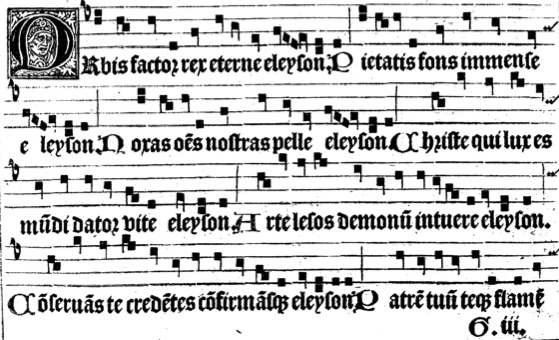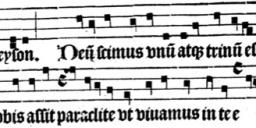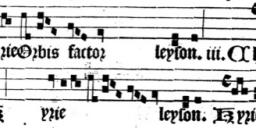Henri Dumont Messe du huitieme ton
-
Does anyone have the complete music for Gloria of Dumont's messe pour les dames religieuses - in the 8th tone?
I want to use it on a recital alternatim-style with Gaspard Corrette's organ mass. I found a good recording from which to transcribe this, but one crucial verse was missing - the penultimate one. -
This unfortunately isn't in the Cinq Messes at Gallica (a search of this forum is the quickest way to get there) nor do I spot it amid the astounding curiosities of Nouveau recueil de messes anciennes et nouvelles en plain-chant ordinaire. Oxford Music Online omits the Henri Dumont article (Plein-chant musical & Neo-gallican chant articles skip him as well), perhaps I'll have time to fetch a bound NG tonight...Thanked by 1M. Jackson Osborn
-
There is a recording on youtube by Lionel Bernard of Gaspard Corrette's only surviving organ mass. It is excellently played with alternatim chant in the huitieme ton said to be by Henri Dumont. It certainly is not one of the Gregorian masses. I have been able to transcribe it from the recording, but, unfortunately, the penultimate verse of the chant is missing. Thanks would be generously bestowed upon anyone who can supply this want.
-
I was able to find this but I'm not sure it's any more than what's posted above.
http://gallica.bnf.fr/ark:/12148/btv1b9009986q -
Are you sure this is a Mass by Dumont? So far as I am aware, he only composed five Masses in the style of plainchant, which became known after his death as Messes Royales: those in the first (the Messe Royale par excellence), second, fourth, fifth and sixth tones; of these, only the first, second and sixth were republished in chant notation in the twentieth century, as a supplement to the Liber Usualis. I have seen the music for his Messe Royale in the first tone mislabelled as being in the eighth tone, which may explain the problem. I append the Gloria from each of his five Masses (three of which I have marked with dots to match the Polish organ accompaniment available elsewhere on this site), so you can check if it is one of these. I certainly have never found reference to any other plainchant Masses by Dumont.

 Messe Royale - Gloria Dotted Typeset.pdf24K
Messe Royale - Gloria Dotted Typeset.pdf24K
 Gloria (dotted) Messe du 2e ton.pdf24K
Gloria (dotted) Messe du 2e ton.pdf24K
 Messe du 4e ton - Gloria Typeset.pdf24K
Messe du 4e ton - Gloria Typeset.pdf24K
 Messe du 5e ton - Gloria Typeset.pdf25K
Messe du 5e ton - Gloria Typeset.pdf25K
 Gloria (dotted) - Messe du 6e ton.pdf24K
Gloria (dotted) - Messe du 6e ton.pdf24K -
Josh -
Many thanks for this! The Gloria sung on the Lionel Bernard youtube version is the Dumont one in the sixth tone. Curious, because Corrette's organ pieces are in the eighth tone, which, for all practical purposes here is the key of G. However, Dumont's sixth tone mass fits perfectly with it on Bernard's youtube performance.
I can see now that Bernard omits in gloria dei patris. Amen, and simply plays the last two of Corrette's versets one right after the other, which I think is not right. I shall have my schola sing in gloria dei patris, followed by the last organ verset standing in for amen.
You have been enormously helpful. Thanks so much!!! -
Acchhh! Missa de Angelis is sooooo old hat.
And! You wouldn't want to get Fr Columba started about it.
I guess one could consider it (and the orbis factor kyrie) a nice vocalise - nothing more.
Listen to the youtube version of the Corrette-Dumont I mention above.
I'm sure you'd like it. -
The Kyrie of Mass XI has a more ancient pedigree than that of Mass VIII...
-
Orbis factor's Kyrie A does indeed have an older pedigree, but is only a little more interesting than the much later variant, Kyrie B, which is hardly more than an amusing vocalise for musically challenged folk.
As for De Angelis, well, anything I say about it wouldn't hold a candle to the excoriations on offer from Fr Columba - excoriations well deserved. -
Which is A & which is B? The one included in the Graduale Romanum with Mass XI is of a later origin than the one included in the chants ad libitum, but AFAIK is still older than de Angelis by at least a century. Certainly it’s taken from the chant which Solesmes marks ad libitum.
Also, tropes and organum make it more interesting. :) -
I refer to the A & B as given in Graduale Triplex. The sole one appearing in Liber Usualis corresponds to Kyrie B of the GT, which is downright modern - an incredibly facile variant of the earlier version in GT.
-
Both Kyrie's for Orbis factor are included in the Liber Usualis; indeed they both appear also in the Graduale Romanum (1908). It is just that the older one is in the Cantus ad Libitum section of the Kyriale, where it is number X.Thanked by 1M. Jackson Osborn
-
Orbis factor is in the Sarum books...I think these versions are rather good, of course most of you are banned from singing the Troped version.
Scans from the Graduale Sarisburiensis, 1508.



 Orbis1.jpg559 x 340 - 96K
Orbis1.jpg559 x 340 - 96K
 Orbis2.jpg556 x 164 - 47K
Orbis2.jpg556 x 164 - 47K
 Orbis3.jpg559 x 164 - 42K
Orbis3.jpg559 x 164 - 42K -
I have consoled myself with the thought that Credo III, which of course we will sing with Mass VIII, is just as late (17th C.) as Dumont's Messe du 6e ton (1669), which I had hoped to use instead. If it ain't Baroque...Thanked by 1hilluminar
-
I'm searching now for any XVIIth century 'messe du huitieme ton' that might have been sung with Gaspard Corrette's Messe du huitieme ton pour la Usage des Dames Religieuse
While Henri Dumont's mass in the sixth tone (as given above by Josh) is successfully paired with several recordings of Corrette's mass, I would like to find an eighth tone mass to sing with Corrette's mass on a recital later this autumn. Does anyone here know of other such 'newly composed' masses of the period which would match this organ mass tone-wise? I don't seem to have anything about these sorts of masses in my library. Was Dumont a singular phenomenon, or are there others? Corrette's mass hasn't the vaguest intimation of a c.f. - nor does it work with any of the Gregorian glorias, not even Cunctipotens, which was the default French mass at this time.
Lacking a period eighth tone mass I will use the sixth tone Dumont one, for which I thank Josh for having provided. -
A chant Mass in the 8th tone would also be useful to turn up for use with Couperin's Mass "for the Convents".Thanked by 1M. Jackson Osborn
-
I'm not sure if it's exactly what you're looking for but I have these.
https://drive.google.com/open?id=0B4L7cTmcIRVEanZXeUFka053NjQ
https://drive.google.com/open?id=0B4L7cTmcIRVERFExQXNoRFhSOVE
https://drive.google.com/open?id=0B4L7cTmcIRVEcTlJRDgtbnV5WG8
R -
Many thanks, Cantus -
I'll add these to my library.
It seems as though I shall have to pair Corrette's VIIIme ton organ mass with du Mont's VIme ton mass. Singing it on G as a 'tonic' this does work, as may be heard on the youtube recordings which I have cited above. I think, Jonathan, that it would work as well with Couperin's convents mass.
Were there others writing these masses? Surely du Mont was not the only one.Thanked by 1Cantus67 -
I'm not sure about the others but a Kyriale in Peregrinus tone would be interesting. IF there is such a thing.Thanked by 1M. Jackson Osborn
-
Hello, MJO:
The Messe Royale I by Dumont is in the eighth mode---at least that is how it is marked in the copy of a chant manuscript I have from a French website. Trying to find that website now.
The organ accompaniment from the Polish Kyriale here is attached below:
Can't find the website now, but the copy I have is the same as the one shown on this video which is marked "VIII": https://www.youtube.com/watch?v=csSTIlYhc_o
 Missa Regia I.pdf508K
Missa Regia I.pdf508K -
JulieColl - don't believe all you find online. The Messe Royale is definitely in mode I, not mode VIII - the chant and so forth to which you refer has been labelled wrongly.
-
I thought so.
But it does work nicely with ton VIII organ masses.
Should one, then, assume that an organ mass labeled in 'ton such and such' ought to be paired with a 'ton such and such' plain-chant musical setting such as du Mont's, rather than one from the Gregorian repertory? It is beginning to seem so. All the more so since the 'ton such and such' masses do not quote or refer to a Gregorian cf - Couperin's two very different masses being a handy case in point... one based (however loosely) on Cunctipotens genitor Deus, and the other being void of any cf reference. This is beginning to become clear to me. -
I would choose a messe en pleinchant musical, or assemble a set of ordinary parts in the proper mode -- from proper preSolesmes mensural editions, if course.Thanked by 1M. Jackson Osborn
-
Thanks, Josh!
-
Kyrie from Henri du Mont's Messe Royale I as interpreted by the Choir Saint-Just. Video from FSSP Lyon.
https://www.facebook.com/518769598264216/videos/797093347098505/ -
Yes, there are other quasi-chant style masses from the time of Dumont. Reposting this from Sept. 2013. Rob, Portland, Oregon
While investigating the masses of Dumont, I came across some other mass settings in a quasi-plainchant style.
The first is Cinq messes en plainchant musical. I found it easy to download from this site
http://gallica.bnf.fr/ark:/12148/btv1b9059803g
The second is in Google Books, and is Nouveau recueil de messes anciennes et nouvelles en plain-chant ordinaire, and it is in Google Books. A link MIGHT be
http://books.google.com/books?id=H7O6e3RjSgAC&source=gbs_similarbooks
If that doesn't work, plug in the name. You may need to hover over the red
ebook free button to find where to download the pdf.
I posted about the second of these books on a Yahoo Gregorian Group and got this response:
Hi Rob; I have had a quick look; it is very interesting and practical music.
I notice that the last mass is in time (i.e. 4/4) if you make the square with stem a half note, the regular square a quarter note, and the diamond an eighth. Sharps and flats are marked; clefs are C and F (F has the extra blob on the left). And we have unison, duos and trios.
I think we will try some of these at my church; we have a small but good choir. probably only kyrie, sanctus and agnus for now.
In the triple time Salvum fac that opens the collection, stemmed note would equal dotted quarter, diamond = eighth, square = quarter. Small notes are like graces in baroque music. Two notes same pitch right beside one another are like a tied note. Sharps are x.
In the plainchant masses it appears that the rhythmic notations is essentially giving longs and shorts in accordance with the stress of the latin syllables--as is found in other post-tridentine chant sources (not my area of knowledge) so again a stem is long, a square is normal and a diamond is short; but I wouldn't do that in a mechanical way.
This type of notation also appears in the Merbecke Mass that was mentioned.
William Renwick
School of the Arts
McMaster University
Hamilton Ontario CANADA L8S 4M2 http://www.humanities.mcmaster.ca/~renwick/wr.htm
I hope these will be of use, and of interest, to those who have been looking for more chant ordinaries.
Of course, these aren't ancient melodies; those are scattered all over in libraries where many have never been cataloged, so we just have to wait for scholars to unearth them and prepare performing editions!
Rob
Portland, Oregon -
.
-
With nine versets, and the divisions of the Gloria as they are in the Vatican Edition Graduale Romanum (1908), one would get:
***Chant — Gloria
1. Organ — Et in terra
***Chant — Laudamus te
2. Organ — Benedicimus te
***Chant — Adoramus te
3. Organ — Glorificamus te
***Chant — Gratias agimus tibi
4. Organ — Domine Deus, Rex coelestis
***Chant — Domine Fili
5. Organ — Domine Deus, Agnus Dei
***Chant — Qui tollis… miserere
6. Organ — Qui tollis… suscipe
***Chant — Qui sedes
7. Organ — Quoniam tu solus sanctus
***Chant — Tu solus Dominus
8. Organ — Tu solus Altissimus
***Chant — Cum Sancto Spiritu
9. Organ — Amen
Do you have a different number of versets, or different divisions?
Also, HERE is a CD that I found through Naxos which looks like it follows these divisions. -
Thanks, Jonathan -
I see now what I did.
A certain otherwise splendid alternatim performance omitted a line of chant and played two organ versets in a row at the end. (Argh!)
All is well - now.Thanked by 1CHGiffen
Welcome to the MusicaSacra Forum!
To participate in the discussions on Catholic church music, sign in or register as a forum member, The forum is a project of the Church Music Association of America.
Categories
- All Discussions21,110
- General Music Discussion8,218
- Job Openings197
- Management of Music Programs850
- Choral Matters533
- Church Documents and Rubrics524
- CMAA Notes302
- Events716
- For Newcomers: Read First26
- Sacred Polyphony546
- Hymnody872
- Gregorian Chant: General2,698
- ↳ Graduale Romanum and Liber Usualis368
- ↳ Graduale Simplex60
- ↳ Semiology63
- Vernacular Plainsong696
- Anglican Use and Anglican Chant68
- Organ, Other Instruments and Repertoire435
- New Composition/Works in Progress1,291
- Recordings232
- Music for Hispanic Ministry159
- Music Education: Children211
- Music Education: General222
- News Items245
- Positions Wanted2
- General Discussion: Catholicism739
- Amusements177
- General Discussion1,034
- Opinions117






